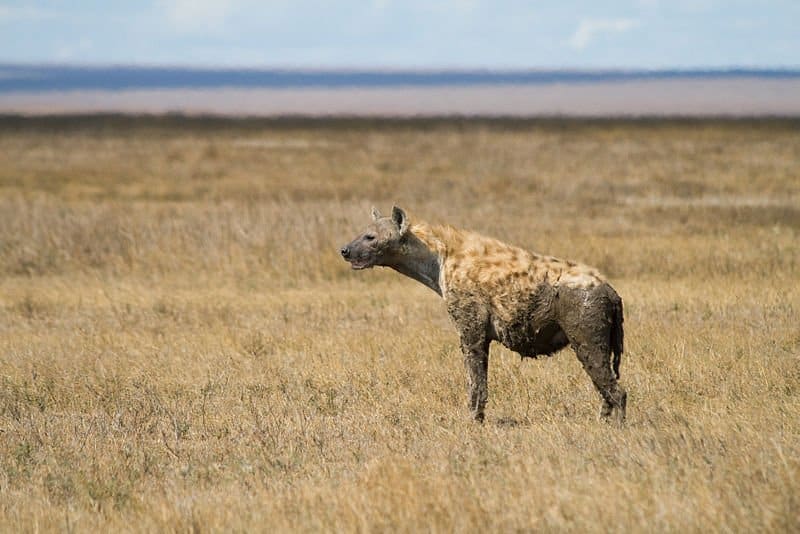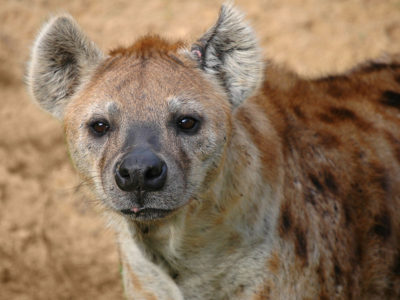Hyena
.jumbotron {
background-image: url(“https://a-z-animals.com/media/animals/images/original/hyena1-400×300.jpg”);
}
}
@media only screen and (min-width: 641px) and (max-width: 920px) {
.jumbotron {
background-image: url(“https://a-z-animals.com/media/animals/images/original/hyena1-470×370.jpg”);
}
}
@media only screen and (min-width: 921px) {
.jumbotron {
background-image: url(“https://a-z-animals.com/media/animals/images/original/hyena1.jpg”);
}
}
There are four different species!
Hyena Scientific Classification
- Kingdom
- Animalia
- Phylum
- Chordata
- Class
- Mammalia
- Order
- Carnivora
- Family
- Hyaenidae
- Genus
- Crocuta
- Scientific Name
- Crocuta Crocuta
Read our Complete Guide to Classification of Animals.
Hyena Conservation Status
Hyena Facts
- Main Prey
- Wildebeest, Monkey, Birds
- Habitat
- Open savanna plains and grassland
- Diet
- Carnivore
- Average Litter Size
- 3
This post may contain affiliate links to our partners like Chewy, Amazon, and others. Purchasing through these helps us further the A-Z Animals mission to educate about the world’s species..

Spiders that fly! Fish that walk! And 1000+ more incredible animals. Discover them all for FREE
.photo-gallery {
–margin: 0px auto 0px;
–padding: 0px 0px 0px 0px;
}
.gallery-link {
background-image: url(“https://a-z-animals.com/media/animals/images/original/hyena_3-1024×683.jpg”);
background-repeat: no-repeat;
background-size: cover;
background-position: center;
height: 500px;
justify-content: center;
text-align: center;
align-items: center;
display: flex;
border: 2px solid #000;
}
.gallery-link img {
height: 50%;
}
@media only screen and (max-width: 768px) {
.gallery-link {
height: 300px !important;
}
}
Hyenas are animals that are biologically closer to cats than dogs.
Humans tend to make snap judgments about these animals. We think of them as savage gluttons with demonic laughs. But it’s an unfair characterization. In reality, they are sociable and smart. Plus, they play a vital role in the African, Middle Eastern, and Asian ecosystems. Hyenas rival lions in terms of predatory prowess and the spotted hyena’s community structure will make you shout, “no way!” So, let’s abandon our assumptions and dive into the wild and wondrous world of these animals.
9 Fascinating Hyena Facts
- Talking hyenas are a staple in Disney animated features, including Dumbo, Lady and the Tramp, Noah’s Ark, Bedknobs and Broomsticks, and, of course, The Lion King.
- In 1999, the lions and hyenas of Ethiopia’s Gobele wilderness went to war. The situation grew so deadly that the military intervened. In the end, the lions killed 35 hyenas, and the hyenas managed to kill six lions.
- In some parts of Somalia, these animals are a delicacy.
- Some species have bright white feces due to the large amount of calcified bones they eat.
- Females dominate in spotted hyena clans.
- Contrary to popular belief, hyenas have more in common with cats than dogs.
- The 26th president of the United States, Teddy Roosevelt, maintained an animal menagerie that included a hyena.
- Ancient Greeks and Romans believed hyena parts were effective shields against evil and ensured fertility.
- Hyenas have one of the strongest bite forces in the animal kingdom. The spotted hyena has a bite force of 1,100 PSI, whih is slightly below a polar bear‘s bite force of 1,200 PSI. Hyenas have a bite force that’s greater than lions.
You can check out more incredible facts about hyenas.
Scientific Name
The scientific name for hyena is Hyaenidae, which doubles as the animal’s taxonomic family that includes four extant species dispersed over three genera.
These include:
- Aardwolf (Proteles cristata)
- Brown hyena (Hyaena brunnea)
- Spotted hyena (Crocuta crocuta)
- Striped hyena (Hyaena hyaena)
Aardwolf Scientific Name
The scientific name for aardwolves — which means “earth-wolves” in the Afrikaans and Dutch languages — is Proteles cristata. Proteles is a portmanteau of two ancient Greek words, teleos and protos, which roughly translate to “complete” and “front or first,” respectively. Combined, they mean “complete in front,” a reference to the aardwolf’s five-toed front feet.
Cristata derives from the Latin word “cristatus,” which means “provided with a comb,” a reference to the animal’s mane.
Other names for aardwolf include “maanhaar-jackal,” “any hyena,” “termite-eating hyena,” and “civet hyena.” The Nama people use “|gīb” to label the animal.
Brown Hyena Scientific Name
Hyaena brunnea is the scientific name for the brown hyena. Hyaena derives from the ancient Greek word “hyaina,” which evolved from “hys,” meaning hog or pig. Under the Roman pen, hyaina became hyaena, and when Middle English emerged as the prominent language, hyaena morphed into hyena.
Brunnea comes from the Latin word “brunneus,” which means “brown.”
Brown hyenas are also known as strandwolves.
Spotted Hyena Scientific Name
The scientific name for the spotted hyena is Crocuta crocuta. For decades, people thought “crocuta” came from the Latin word “crocutus,” which means “saffron-colored one,” but they were wrong. The taxonomic label for spotted hyenas comes from the ancient Greek word “Κροκόττας,” which translates to “golden jackal.”
Colloquially, spotted hyenas are also known as laughing hyenas.
Striped Hyena Scientific Name
Hyaena hyaena is the scientific name for striped hyenas. As we discussed under the brown hyena section, Hyaena derives from the ancient word “hyaina,” which relates to wild pigs. The Greeks associated the two animals because they both had manes.
Hyena Appearance
These animals belong to the carnivorous suborder Feliformia — sometimes called Feloidea — which includes meat-eating mammals with “cat-like” physical and behavioral features. Currently, there are four species of these animals scavenging throughout large swaths of Africa, the Middle East, and Eurasia.
Generally speaking, hyenas are four-legged animals with scraggly fur and large ears. Interestingly, they have both feline and canine features, and all sport manes. They also have downward sloping spines, long front legs, and short hind legs. Learn about the ugliest animals on earth here.
Aardwolves, brown -, and striped hyenas have lined coats. The spotted hyena, as its name suggests, sports dotted pelage. Like dogs, their short claws are non-retractable, but they have more ribs than canids and rough tongues similar to felines.
Male individuals in the aardwolf, striped, and spotted hyena species are usually larger than their female counterparts. In the spotted variety community, however, the women are bigger. They dominant the males and even have external genitalia.

How Big Are Hyenas?
Hyenas vary in size depending on the species and sex.
| Species | Sex | Average Height | Average Length | Average Weight |
| Aardwolf | Female | 16 to 20 inches | 22 to 31 inches | 15 to 22 pounds |
| Aardwolf | Male | 16 to 20 inches | 22 to 31 inches | 15 to 22 pounds |
| Brown | Female | 28 to 31 inches | 51 to 63 inches | 83 to 89 pounds |
| Brown | Male | 28 to 31 inches | 51 to 63 inches | 89 to 96 pounds |
| Spotted | Female | 28 to 36 inches | 37 to 65 inches | 98 to 153 pounds |
| Spotted | Male | 28 to 36 inches | 37 to 65 inches | 89 to 149 pounds |
| Striped | Female | 24 to 31 inches | 33 to 51 inches | 49 to 121 pounds |
| Striped | Male | 24 to 31 inches | 33 to 51 inches | 49 to 121 pounds |
Hyena Behavior
Like house cats, these animals are avid groomers that also mark territory, but they use anal glands instead of urination. They’re primarily a nocturnal species, though spotted hyenas occasionally venture out during the day, especially if humans aren’t poking around.
The striped variety typically lives alone or in pairs, though some populations travel in packs up to seven-deep. Spotted hyenas are the exception. Exceptionally sociable, they live in highly organized communities of up to 80 individuals. Matriarchal and monarchical by nature, females of the species dominate. Plus, when a pack leader dies, her oldest daughter automatically takes over!
Mostly they burrow in caves and under crevices. Striped hyenas also dig dens.
The animals vocalize loudly and frequently. However, not all species laugh, as is often assumed. In fact, spotted hyenas are the only extant species known for laughing. Notably, they use about a dozen distinct grunts, laughs, and barks to communicate with their clan members about food and migration efficiently.
Hyena Habitat
These animals live throughout Africa, the Middle East, and parts of Asia. Aardwolves roam in southern and eastern Africa, whereas brown hyenas stick to South Africa, Namibia, and Botswana, with some overflow into Angola, Zimbabwe, and Mozambique. The spotted variety’s range is central, western, and southern Africa, though very few live in South Africa. Striped hyenas cover northern Africa, the Middle East, and large swaths of India.
Aardwolves live in bushlands and heavily grazed arid plains where termites — an essential part of their diet — are plentiful. Typically, aardwolves stay in the same place for about six weeks and cluster their dens together.
Deserts and coastal lands are where you’ll find the brown variety, whereas spotted populations favor woodlands, savannahs, semi-deserts, and hilly forests below 4,000 meters. Striped hyenas prefer dry woodlands in mountainous regions, savannahs, and dense grasslands. Typically, they make dens in rocky outcrops, ravines, and crevices.
Hyena Diet
These animals are primarily scavengers, but they also kill prey. As carnivores, they mostly consume meat but have been known to supplement their diets with fruit in tough times. They are also members of the “clean plate club,” meaning they eat every last bit of a kill, including bones and hooves. Plus, they aren’t particularly picky about what type of meat they eat.
These animals have digestive systems made of steel! So much so that field scientists and anthropologists often report of them feasting on inanimate objects, like tires and tent materials.
Aardwolf Diet
Aardwolves’ primary source of nourishment is termites from the genus Trinervitermes. Using sound and scent clues, aardwolves locate the crawlers and lick them off the ground using their sticky tongues. In a single night, an individual aardwolf may consume upwards of 250,000 insects. Conscious of their constant need for sustenance, aardwolves never eat an entire pile of termites. Instead, they leave it partly intact, and the mound serves as a replenishing source.
The aardwolf diet differs from other hyena species because it doesn’t include any carrion, which is the meat of an already killed animal. Instead, aardwolves stick to insects and larva.
Brown Hyena Diet
These animals aren’t great hunters. As such, they rely on carcasses killed by other predators. They also supplement their meals with rodents, insects, eggs, fruit, and fungi.
Spotted Hyena Diet
Spotted hyenas, arguably the most aggressive Hyaenidae species, differ from their cousins because they primarily hunt prey instead of sticking to carrion. Except for spotted populations in west Africa, who largely scavenge for meat, the species preys on large, hooved, plant-eating animals, including, but not limited to, wildebeests, giraffes, gazelles, impalas, gemsboks, sheep, goats, and cattle. They’ve also been known to catch fish, and, on rare occasions, humans!
These animals have huge appetites. A single individual can pack away up to 32 pounds of meat in a single feeding!
Striped Hyena Diet
These animals are scavengers who eat almost any meat, though they turn their noses up at vulture flesh. They also feast liberally on bones and bone marrow.
Hyena Predators and Threats
Lions are These animals’ primary foe even though the former usually don’t eat the latter. But lions see them as fellow apex predators and will kill them to reduce competition. Similarly, in the Middle East, striped hyenas compete with wolves for food. But at times, the two animals cooperate and travel in joint-species hunting packs.
Leopards also prey on these animals in certain regions.
According to conservationists, aardwolf and spotted hyenas currently enjoy stable wild populations and don’t face imminent extinction. Striped and brown varieties aren’t as fortunate because humans are increasingly encroaching on their natural habitats and killing them at alarming rates using traps, poison, and wire snares. Farmers often eliminate brown hyenas in retaliation for livestock deaths. In reality, though, they don’t kill prey; they only scavenge for dead animals, which sometimes includes already deceased livestock.
Hyena Reproduction, Babies, and Lifespan
Hyena Reproduction
Spotted, brown, and aardwolf hyenas copulate with several partners in a lifetime. Striped hyenas, on the other hand, are monogamous, meaning they mate with the same partner for most of their lives.
For the spotted variety, mating is an awkward and tricky process since both the male and female have genitalia on the outside of their bodies. The male has to position himself just right in order to successfully mate with the female. This process often is described as a dance because of all the jumping around he has to do.
| Species | Gestation Period | Mating Season | Litter Size | Parental Responsibility |
| Aardwolf | 89 to 92 days | Spring or Autumn depending on location; July in South Africa | 2 to 5 cubs | Both parents raise cubs |
| Brown | 90 days | May to August, but occasionally mate out of season | 1 to 5 Cubs | Males help provide food for cubs |
| Spotted | 110 days | All year, but prefer wet season | 2 Cubs | No male help |
| Striped | 90 to 91 days | Either January and February or October and November depending on location | 1 to 6 Cubs | Both parents raise cubs |
Babies
The babies are called cubs. At birth, aardwolves, brown, and striped hyenas are born with closed eyes and require adult help. Spotted hyenas, however, are born fully developed, with open eyes and teeth!
Lifespan
These animals usually live for about 12 years, but they can live up to 25 years. Brown hyenas, however, typically have shorter lives.
The oldest specimen ever was a male spotted hyena named Mars who lived in the Honolulu Zoo with his brother, Whoops. Both arrived in 1992, and both had unusually long lives. Mars broke the record with 28.5 years, and Whoops made it to 26!
Population
According to the International Union for the Conservation of Nature, aardwolves and spotted hyenas are populations of least concern, meaning they’re currently not in danger of extinction. However, brown and striped hyenas are classified as near threatened, and scientists are employing conservation efforts to combat declining population numbers.
View all 72 animals that start with H
Hyena FAQs (Frequently Asked Questions)
Are Hyenas Carnivores, Herbivores, or Omnivores?
Hyenas are primarily carnivores that subsist on meat and bones. However, aardwolves stick to termites and larva, and several hyena species will supplement their diets with fruit to get through lean times.
What is a Hyena?
A hyena is a four-legged, carnivorous mammal that has both dog-like and cat-like features. However, biologically, hyenas are more closely related to felines than canines. Hyenas live in Africa, the Middle East, and Asia and play an essential role in the areas’ ecosystems.
Are Hyenas Dogs or Cats?
Hyenas are neither dogs nor cats, but they are Feliformias, meaning they have cat-like anatomical qualities. And while hyenas share characteristics with canines, they are in no way considered dogs, scientifically speaking.
Are Hyenas Aggressive?
Yes, hyenas can be incredibly aggressive, especially the spotted species. spotted and spotted hyenas have been known to attack humans. Brown hyenas and aardwolves are considerably less bloodthirsty.
Can a Hyena Kill a Lion?
Yes, hyenas can kill lions! In the 1990s, a massive war between hyenas and lions broke out in Ethiopia for several weeks. During the conflict, hyenas managed to take down six lions. In the end, the military had to intervene and quell the conflict.
What Does a Hyena Look Like?
Instinctively, people think of hyenas as unfortunate looking. But closeup photos reveal adorable faces. However, hyenas’ pelage is not fluffy and full. As such, they usually appear scraggly and unkempt.
How Much Does a Hyena Weigh?
Depending on species, hyenas can weigh anywhere between 15 and 155 pounds. Aardwolves weigh the least and spotted hyenas the most.
What Kingdom do Hyenas belong to?
Hyenas belong to the Kingdom Animalia.
What phylum do Hyenas belong to?
Hyenas belong to the phylum Chordata.
What class do Hyenas belong to?
Hyenas belong to the class Mammalia.
What family do Hyenas belong to?
Hyenas belong to the family Hyaenidae.
What order do Hyenas belong to?
Hyenas belong to the order Carnivora.
What genus do Hyenas belong to?
Hyenas belong to the genus Crocuta.
What type of covering do Hyenas have?
Hyenas are covered in Fur.
In what type of habitat do Hyenas live?
Hyenas live in open savanna plains and grasslands.
What is the main prey for Hyenas?
Hyenas prey on wildebeest, monkeys, and birds.
What are some predators of Hyenas?
Predators of Hyenas include lions, leopards, and crocodiles.
What is the average litter size for a Hyena?
The average litter size for a Hyena is 3.
What is an interesting fact about Hyenas?
There are four different species of Hyena!
What is the scientific name for the Hyena?
The scientific name for the Hyena is Crocuta Crocuta.
What is the lifespan of a Hyena?
Hyenas can live for 20 to 25 years.
How fast is a Hyena?
A Hyena can travel at speeds of up to 37 miles per hour.
Do hyenas make good pets?
Adult hyenas do not make good pets because they are aggressive and prone to attack animals – including humans – that attempt to dominate them.
Who Would Win in a Fight Between a Leopard and a Hyena?
A leopard would win a fight against a hyena. The big cat is too skilled and deadly for the hyena to beat in a fight. Hyenas are used to fighting with backup in the form of their pack mates. However, they would come into this fight alone, putting them at an instant disadvantage.
Meanwhile, leopards live, hunt, and fight alone. Moreover, they take down big prey all by themselves. If the leopard was allowed to ambush the hyena, the fight would be over in seconds with the leopard’s mouth around its enemy’s neck.
Who would win in a fight between a jackal and a hyena?
A hyena would win a fight against a jackal because it is larger, stronger, and has better tools with which to kill its foes.
Sources
- David Burnie, Dorling Kindersley (2011) Animal, The Definitive Visual Guide To The World’s Wildlife
- Tom Jackson, Lorenz Books (2007) The World Encyclopedia Of Animals
- David Burnie, Kingfisher (2011) The Kingfisher Animal Encyclopedia
- Richard Mackay, University of California Press (2009) The Atlas Of Endangered Species
- David Burnie, Dorling Kindersley (2008) Illustrated Encyclopedia Of Animals
- Dorling Kindersley (2006) Dorling Kindersley Encyclopedia Of Animals
- David W. Macdonald, Oxford University Press (2010) The Encyclopedia Of Mammals
















